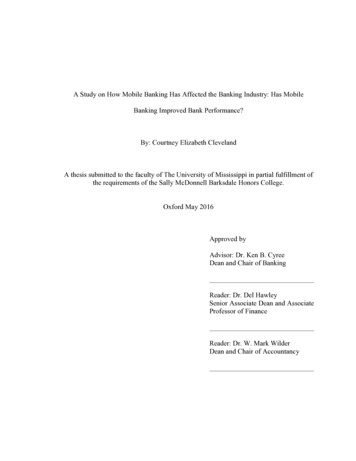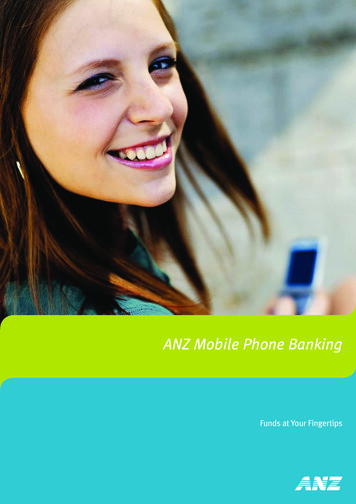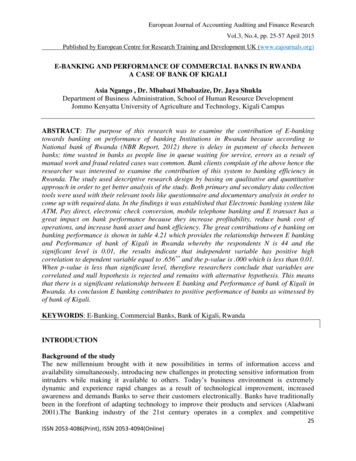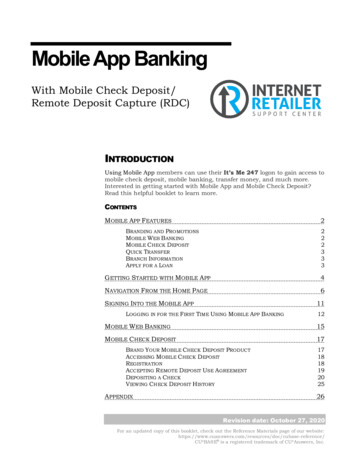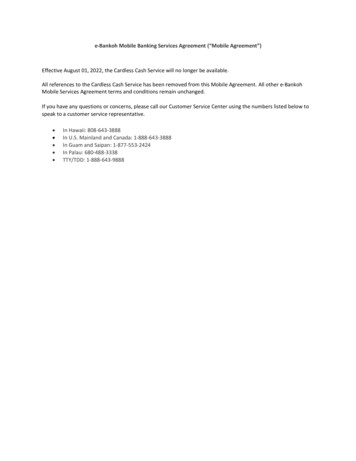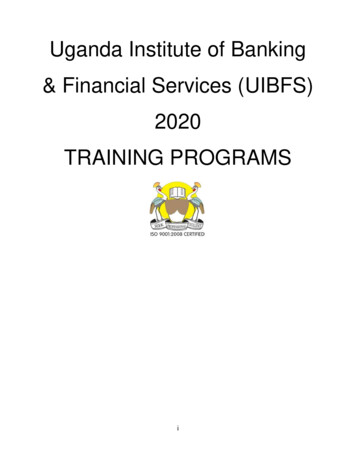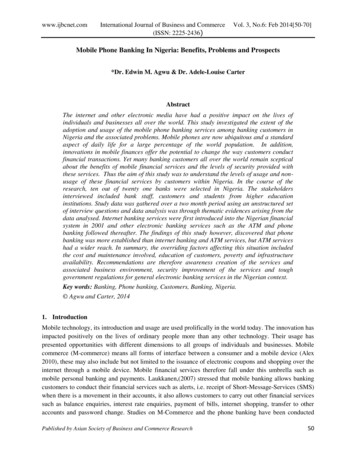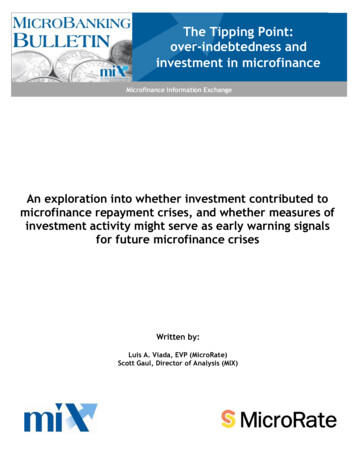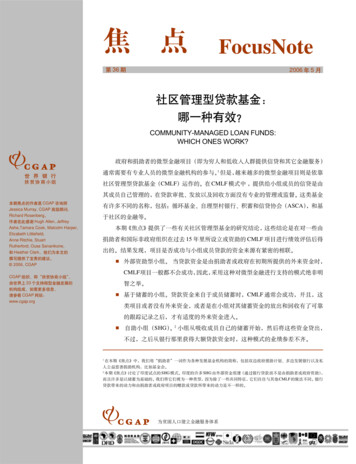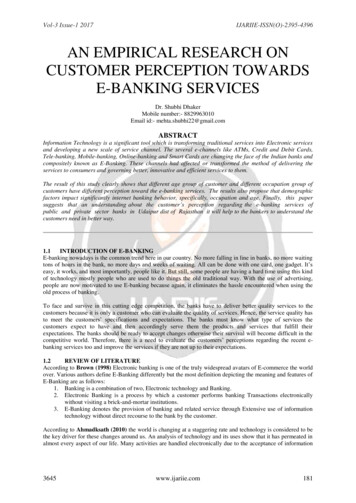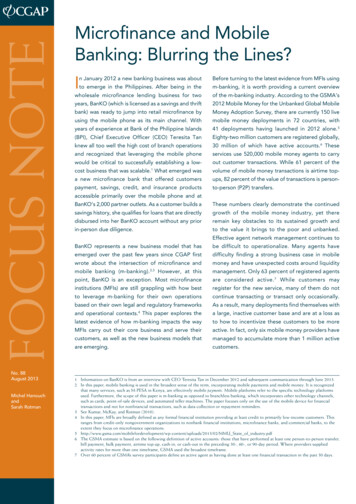
Transcription
focus noteNo. 88August 2013Michel HanouchandSarah RotmanMicrofinance and MobileBanking: Blurring the Lines?n January 2012 a new banking business was aboutIBefore turning to the latest evidence from MFIs usingto emerge in the Philippines. After being in them-banking, it is worth providing a current overviewwholesale microfinance lending business for twoof the m-banking industry. According to the GSMA’syears, BanKO (which is licensed as a savings and thrift2012 Mobile Money for the Unbanked Global Mobilebank) was ready to jump into retail microfinance byMoney Adoption Survey, there are currently 150 liveusing the mobile phone as its main channel. Withmobile money deployments in 72 countries, withyears of experience at Bank of the Philippine Islands41 deployments having launched in 2012 alone.5(BPI), Chief Executive Officer (CEO) Teresita TanEighty-two million customers are registered globally,knew all too well the high cost of branch operations30 million of which have active accounts.6 Theseand recognized that leveraging the mobile phoneservices use 520,000 mobile money agents to carrywould be critical to successfully establishing a low-out customer transactions. While 61 percent of thecost business that was scalable. What emerged wasvolume of mobile money transactions is airtime top-a new microfinance bank that offered customersups, 82 percent of the value of transactions is person-payment, savings, credit, and insurance productsto-person (P2P) transfers.1accessible primarily over the mobile phone and atBanKO’s 2,000 partner outlets. As a customer builds aThese numbers clearly demonstrate the continuedsavings history, she qualifies for loans that are directlygrowth of the mobile money industry, yet theredisbursed into her BanKO account without any priorremain key obstacles to its sustained growth andin-person due diligence.to the value it brings to the poor and unbanked.Effective agent network management continues toBanKO represents a new business model that hasbe difficult to operationalize. Many agents haveemerged over the past few years since CGAP firstdifficulty finding a strong business case in mobilewrote about the intersection of microfinance andmoney and have unexpected costs around liquidityHowever, at thismanagement. Only 63 percent of registered agentspoint, BanKO is an exception. Most microfinanceare considered active. 7 While customers mayinstitutions (MFIs) are still grappling with how bestregister for the new service, many of them do notto leverage m-banking for their own operationscontinue transacting or transact only occasionally.based on their own legal and regulatory frameworksAs a result, many deployments find themselves withand operational contexts.4 This paper explores thea large, inactive customer base and are at a loss aslatest evidence of how m-banking impacts the wayto how to incentivize these customers to be moreMFIs carry out their core business and serve theiractive. In fact, only six mobile money providers havecustomers, as well as the new business models thatmanaged to accumulate more than 1 million activeare emerging.customers.mobile banking (m-banking).2,31 Information on BanKO is from an interview with CEO Teresita Tan in December 2012 and subsequent communication through June 2013.2 In this paper, mobile banking is used in the broadest sense of the term, incorporating mobile payments and mobile money. It is recognizedthat many services, such as M-PESA in Kenya, are effectively mobile payments. Mobile platforms refer to the specific technology platformsused. Furthermore, the scope of this paper is m-banking as opposed to branchless banking, which incorporates other technology channels,such as cards, point-of-sale devices, and automated teller machines. The paper focuses only on the use of the mobile device for financialtransactions and not for nonfinancial transactions, such as data collection or repayment reminders.3 See Kumar, McKay, and Rotman (2010).4 In this paper, MFIs are broadly defined as any formal financial institution providing at least credit to primarily low-income customers. Thisranges from credit-only nongovernment organizations to nonbank financial institutions, microfinance banks, and commercial banks, to theextent they focus on microfinance operations.5 t/uploads/2013/02/MMU State of industry.pdf6 The GSMA estimate is based on the following definition of active accounts: those that have performed at least one person-to-person transfer,bill payment, bulk payment, airtime top-up, cash-in, or cash-out in the preceding 30-, 60-, or 90-day period. Where providers suppliedactivity rates for more than one timeframe, GSMA used the broadest timeframe.7 Over 60 percent of GSMA’s survey participants define an active agent as having done at least one financial transaction in the past 30 days.
2This paper aims to answer the following questions:The research methodology consisted of interviewswith selected MFIs that have experimented Section 1: What options do MFIs have to leveragem-banking for microfinance transactions?with or fully implemented m-banking into theirmicrofinance operations. Some of these MFIs are Section 2: What have been the experiences of MFIsthe same ones that were studied in CGAP’s lastthat have served as agents for m-banking systems?paper on the topic with the intent of learning Section 3: Are there benefits for MFIs and theirfrom their activities over the past several years.customers from m-banking? Section 4: Why have some MFIs made the strategicdecision to hold off on m-banking?The other MFIs included in the study are new tom-banking. In contrast to the last paper, where thenumber of relevant MFIs was limited, for this paper, Section 5: How has m-banking created opportunitiesthere were many more MFIs that could have beenfor new innovative microfinance business models toprofiled than space allows. Box 1 summarizes theemerge?main findings of the paper.Box 1. Main Findings There is no evidence that MFIs or their customersare driving the development of m-banking in amarket. MFIs that are successfully leveraging m-bankingtend to be in countries where an m-bankingservice is already widely used. In such markets, MFIcustomers may even expect or demand their MFI tooffer m-banking as a repayment option. The benefits of m-banking services to MFIs largelydepend on the success of the existing m-bankingservice itself. In markets where m-banking is strong,MFIs and their customers can more easily benefit. MFIs are currently using m-banking most often forloan repayments. More MFIs are using m-banking forsavings mobilization than for loan disbursements.aTypical concerns from MFIs about m-banking,namely how it will affect group dynamics andrepayment rates, how management informationsystem reconciliation will occur, and how customersand staff will adjust to new payment options, haveall proven to be manageable by MFIs. MFIs are generally not well placed to build theirown m-banking system and should instead look toleverage existing services. The evidence to date shows mixed results fromMFIs serving as agents for m-banking systems,primarily due to liquidity management costs andcommission incentive structures. There is no real evidence of MFIs reachingcustomers in new geographies or lower incomesegments through m-banking. There is qualitativeevidence of MFIs using m-banking to gain acompetitive advantage; however, this advantage islikely to diminish as more MFIs begin integratingm-banking into their operations. The extent to which operational costs are reducedfor an MFI that uses m-banking depends onwhether the MFI has already transferred the costof loan repayments to the borrower. Likewise,the extent to which savings mobilization throughm-banking is effective in lowering the cost of fundsfor an MFI depends, in part, on whether the MFI orthe customer pays the transaction fee. There is increasing evidence to show that MFIcustomers value the time and cost savings ofm-banking for loan repayments and are betterserved by having the option to repay throughm-banking. One of the biggest determinants of the customerrepayment choice is something as simple as agentproximity compared to branch proximity. Even in a country with a viable m-banking service,there may be institutional or market-specificreasons to postpone the integration of m-banking.A deteriorating loan portfolio is one example. New MFIs should consider going the m-bankingroute from the beginning to avoid the costs andchallenges of change management and to ensurethat the investment in m-banking replaces othercosts, rather than adding to the parallel costs ofcash. One of the biggest recent advances in theintersection between microfinance and m-bankinghas come from new microfinance business modelsthat leverage mobile phones and agents for loanapplications, customer due diligence, and creditdecision-making.a. According to a recent survey by Triple Jump Advisory Services(2013).
31. What Options Do MFIs Haveto Leverage M-Banking forMicrofinance Transactions?of investment since the MFI can import the data andFigure 1 illustrates a traditional microfinance businessthe m-banking platform into the MFI’s managementprocess. While not intended to capture the intricaciesinformation system (MIS)—middleware could alsoof all microfinance models, it is useful to identifybe used to upload and reconcile loan disbursementwhere m-banking plays a role in microfinance. Toand savings data. According to some technologydate, the three main areas where m-banking hasproviders, this middleware in Kenya costs betweenimpacted MFIs most have been loan repayments, loanUS 10,000 and US 20,000, depending on the leveldisbursements, and savings mobilization. In contrast,of automation and the nature of the MFI’s MIS.new microfinance business models, as discussed inAutomation becomes more attractive as the numberSection 5, are innovating across the business process.of customers using the m-banking system for MFIdo manual reconciliation. An MFI can also choose toinvest in “middleware” that automates the process ofuploading and reconciling the repayment data fromtransactions increases, as a lack of automation canMFIs tend to pursue one of two distinct strategies inhamper growth.leveraging m-banking systems, each with differentimplications for the level of investment requiredThe second strategy involves the MFI investing inand functionality offered to customers. (These twotechnology that links customers’ mobile walletsbroad strategies are not exhaustive, but do represent(m-wallets) to their MFI accounts. This allowsthe most common approaches pursued by MFIs tocustomers to access their MFI accounts via theirdate.) The first strategy involves simply using the billmobile phones and to move money between thepay functionality of the existing m-banking provideraccount and m-wallet.8 The MFI leverages the agentand its agent network to facilitate loan repaymentsnetwork of the existing m-banking provider toand/or savings mobilization, or the bulk paymentsfacilitate cash-in and cash-out9 transactions into thefunctionality to facilitate loan disbursements. Incustomer’s m-wallet and subsequently into the MFIthis arrangement, the MFI uses its own bill payaccount. This option may provide the more attractivecode just like a water or gas company would use itssolution for MFIs trying to mobilize savings than theown code to receive bill payments through mobilefirst strategy since savings transferred into the MFImoney. This strategy is the quickest way for an MFIaccount are still accessible through the customer’sto leverage m-banking and requires the lowest levelm-wallet and at the existing m-banking provider’sFigure 1. A traditional microfinance business processMFIs leveraging existing mobile banking systems3Origina onLoanapplica onDue diligence& creditdecisionSavingsmobiliza on2Loandisbursement1LoanrepaymentsPor oliomonitoringLoan reissuance orclosure8 This is most often done by an MFI procuring its own USSD (Unstructured Supplementary Service Data) code. That is, a string of digitstypically starting with an asterisk and ending with the number sign (e.g., *2427#). USSD is one of the most effective communicationchannels for mobile payments. It is known to be more secure and user friendly than SMS, but unlike web-based applications it is available oneven basic handsets. This option is not exclusive to USSD, and could similarly be applied to an MFI using SMS or the Internet to link theircustomers’ existing m-wallets to their customers’ MFI accounts.9 Cash-in transactions facilitate loan repayments and savings mobilization, while cash-out transactions facilitate loan disbursements and accessto the savings.
4agent network.10 In a relatively mature m-paymentsrepayment rates, and whether mobile repaymentsmarket like Kenya where several technologywould increase efficiency or complicate the livescompanies compete to provide these services to theof the loan officers by introducing time-consumingmany financial institutions that link to M-PESA, anmanual reconciliation processes. After several years ofMFI with a robust MIS would need to invest betweenexperience, SMEP DTM reports that despite reducingUS 50,000 and US 100,000 to pursue this option,the frequency of group meetings from weekly toaccording to some technology providers. The cost formonthly, customers have successfully made thethe first movers in other markets could be higher, buttransition without negatively impacting repaymentis likely to decrease over time as the technology andperformance. Some group members still pay weekly,integration processes become more standardized.others pay monthly before the meeting, while othersA number of MFIs in Kenya have transitioned overpay at the meetings themselves.12 The ability to paytime from pursuing the first strategy to pursuing thewhenever it is convenient to do so as well as, in somesecond, allowing for more functionality betweencases, less frequent meetings are both consideredcustomers’ m-wallets and their MFI accounts.significant benefits by customers.It is worth keeping these two strategies in mindTo overcome concerns with manual reconciliation,when considering the experiences of MFIs leveragingSMEP DTM invested in a middleware that betterexisting m-banking systems.integrates its MIS with M-PESA. This has significantlyreduced the requirement for manual reconciliationLoan repaymentsand eased loan officers’ concerns. Loan officersnow more fully support the use of M-PESA, whichWhere there is an existing widely used m-bankinghas had a positive influence on the willingness ofsystem with an extensive well-functioning agentgroup members to also adopt this payment option.network, accepting loan repayments is arguablyThe remuneration of loan officers often dependsthe quickest win for MFIs. There are three thingson the size and quality of their portfolio, so puttingthat typically concern an MFI’s management aboutincentives in place to ensure that loan officers canintroducing this repayment option: how will it affectbenefit from the efficiency that m-banking brings is ingroup dynamics and repayment discipline; how will MISboth the MFI’s and loan officer’s interest.13reconciliation occur; and how will customers and staff,specifically loan officers, adjust to new procedures?Faulu Kenya Deposit Taking Micro-Finance Limitedintroduced m-banking for two main reasons:SMEP DTM Limited is a Kenyan MFI that offers itscustomer demand and cost savings.14 Before offering168,000 customers the ability to use M-PESA forloan repayments via M-PESA, group customers wentloan repayments, loan disbursements, and savingsthrough a lengthy repayment process that involvedmobilization.11 SMEP DTM initially started out indepositing cash into a Faulu account at a commercial2009 merely using the M-PESA bill pay functionality.bank branch and attaching the deposit slip to theThe MFI had all of the common concerns about therepayment form to present at a Faulu branch or grouppotential impact on group cohesion, and thereforemeeting. Now customers can repay loans or make10 The first strategy can be used to mobilize savings by allowing customers to use the bill pay functionality to transfer funds into the MFIaccount. However, customers would not be able to leverage the mobile phone or the existing m-banking provider’s agent network to accessthose funds in the MFI account.11 Information on SMEP DTM is from a meeting between CGAP consultant Tony Oyier and SMEP DTM in January 2013, as well assubsequent communication through June 2013.12 Some groups make repayments using a single mobile phone, whereby the group head receives money from the group members into hisM-PESA wallet, and then deposits money from his M-PESA wallet into the different member’s SMEP DTM accounts.13 Interview with George Kinyanjui in November 2012, as well as subsequent communication through June 2013. Kinyanjui has consulted forseveral MFIs, including SMEP DTM, in their transition to m-banking.14 Information on Faulu is from an interview with ICT Manager Kennedy Kipkemboi in August 2012, and subsequent communication throughJune 2013.
5deposits using their mobile phone through M-PESA.agents, reducing convenience and increasing theIn line with group policy, meetings of the samecost. While Musoni covers the loan disbursement feefrequency and length are still required. To ensure theof US 0.35 charged by Safaricom to credit customers’ongoing stability of the groups and to manage theaccounts, customers are required to pay the US 0.29quality of the portfolio, Faulu continues to providefee for each cash-out (Cracknell 2012). Furthermore,financial education programs for its customers. Withinsplitting the transaction among numerous agentstwo years of launching this service in December 2010,may not fully solve the problem in areas where MFIalmost 54 percent of Faulu’s 300,000 customers hadcustomers are concentrated among only a few agents.registered for m-banking, although only 15,000 ofthese customers were using the service regularly.15SMEP DTM also leverages M-PESA to disburse loans;Those that were using the service were very active, onhowever, its approach is less direct. SMEP DTMaverage doing more than 10 transactions per month,disburses a loan into a customer’s SMEP DTM accountincluding balance enquiries and mini-statements.from where the customer can use SMEP DTM’sm-banking solution to transfer funds into his or herLoan disbursementsM-PESA m-wallet to withdraw at an agent or ATM.Between US 34,700 and US 46,300 is withdrawnWhile a number of MFIs are leveraging m-bankingfrom SMEP DTM accounts using M-PESA on a dailyfor loan disbursements, the high average value ofbasis—double the amount that gets transferred fromloan disbursements compared to loan repaymentsM-PESA to SMEP DTM for loan repayments andcan raise two issues. The first is whether agentssavings. This suggests that customers value access tocan handle these larger transactions, given liquiditytheir funds outside of SMEP DTM branches throughconstraints, and the second is whether transactionthe SMEP DTM m-banking functionality.limits of m-banking services may be too low for someloans.16Prior to leveraging M-PESA for loan disbursements,SMEP DTM relied on checks that cost US 0.64 each.Musoni is a Kenyan MFI that claims to be the first MFIWhile the Safaricom disbursement fee of US 0.35in the world to have gone completely cashless. Byalready offers a 45 percent savings, additional savingsApril 2013, it had about 10,000 customers and hadto the MFI come from reduced staff costs. Reconcilingdisbursed more than US 6.3 million in loans.17,18,19bank statements from checks required two full-timeIn addition to all loan repayments being done viaaccountants, who are no longer required for mobileM-PESA, Musoni also disburses all loans throughdisbursements. For customers, funds are availableM-PESA. However, research conducted with Musoniimmediately because they do not need to wait for thecustomers in 2011 described liquidity constraints atchecks to clear. M-banking can, however, still requireagents. Many agents found it difficult to pay out moresome level of manual intervention typically caused bythan US 58–116 per customer, while Musoni’s loancustomers changing their mobile numbers or errorsproducts range from US 58 to US 2,316 (Sadana etthat occur when entering customer account details.al. 2011).20 As a result, customers wanting to withdrawEven in the case of Musoni, which was specificallythe full loan amount had to withdraw from multipledesigned to work with the M-PESA system, 7–815 16/-/5kkxr3z/-/index.html16 These transaction limits would typically be introduced for regulatory purposes, related to risk management and anti-money laundering andcombating the financing of terrorism (AML/CFT).17 microfinance (accessed 11 April 2013).18 Information on Musoni is from an interview with Chief Finance Officer James Owino in August 2012, as well as subsequent communicationthrough June 2013.19 Throughout this paper an exchange rate of 1 US 5 Ksh. 86.36 has been used (average exchange rate for year to 18 April 2013). Source:http://www.centralbank.go.ke20 http://www.musoni.co.ke/index.php/products (accessed 11 April 2013).
6percent of transactions require manual interventionliquidity challenges. Typical concerns from MFIs about(Cracknell 2012).m-banking, namely how it will affect group dynamics21and repayment rates, how MIS reconciliation willSavings mobilizationoccur, and how customers and staff will adjust to newpayment options, have all proven to be manageableKenya Women Finance Trust (KWFT), a deposit-takingby MFIs. As Box 2 explains, it remains difficult forMFI, has linked its accounts to M-PESA m-walletsMFIs to build their own m-banking systems.as a way to more easily capture deposits.22KWFTestimates that in the first seven months of operatingunder this system, 30 percent of its total deposit basecame from customers transferring funds into theirKWFT accounts using M-PESA. SMEP DTM is also2. What Have Been theExperiences of MFIs ThatHave Served as Agents forM-Banking Systems?successfully leveraging M-PESA to mobilize deposits.In January 2013, between US 17,400 and US 23,200Evidence to date shows mixed results from MFIswas transferred from M-PESA to SMEP DTM per day.serving as agents for m-banking systems. This isWhile these amounts include loan repayments, itdue to two defining characteristics of MFI branchrepresents 30–40 percent of total customer depositsnetworks. First, although many MFIs may have theinto savings accounts.largest branch network among any other financialinstitution in a country, an MFI will have at best aEven outside of Kenya, m-banking is being used fortotal of 200–300 locations. While an MFI can make asavings mobilization. BRAC, one of the world’s largestsignificant contribution to an agent network, an agentmicrofinance lenders, began a pilot in Bangladesh innetwork needs to number in the thousands beforeDecember 2012 among 12 branches offering the mobileit can be considered significant in scale. Second,payments service bKash as a way to make deposits intosince commissions are likely to be collected by MFItheir BRAC savings account.23,24 Among the registeredheadquarters, there is a lack of incentive for themonthly account holders in these branches, 28 percentbranch teller to push the m-banking product. Whilewere using bKash to make deposits within the firstsome MFIs have changed the way agent commissionsthree months of the pilot. Reconciliation with the BRACare shared throughout their branch network, it isMIS is manual, but has not proven to be laborioususually not as direct as an independent agent thatenough to invest in a middleware. BRAC pays thereceives commissions directly from transactions andbKash transfer costs on behalf of customers since BRACis incentivized to invest the time to show customerssees the value in getting more savers into the systemhow to use the service.and subsequently a lower cost of capital.Kafo Jiginew, one of the largest MFIs in Mali withIn summary, there are increasing examples of MFIs280,000 depositors and 46,000 borrowers,25 has usedleveraging m-banking to facilitate loan repayments.102 of its 169 branches as Orange Money agents sinceMFIs, most notably in Kenya, are also having successOrange Money launched in 2009.26 The main advantageusing m-banking to mobilize additional savings. Fewerfor Orange is that this partnership brings over a 100MFIs use m-banking to facilitate loan disbursements,new agent points into its network through one singleand those that do continue to experience agentnegotiation with Kafo Jiginew’s management. Orange21 This figure was from 2012 and was reportedly decreasing at the time.22 Information on KWFT is from a meeting among Tony Oyier (CGAP consultant), Isabella Nyambura (assistant to the MD), and ChristineMwea (general manager, Liabilities) in January 2013, as well as subsequent communication through June 2013.23 bKash is an m-banking service that operates as a subsidiary of BRAC Bank and began operations in July 2011.24 Information on the BRAC savings pilot is from Sazzad Hossain (BRAC) and Greg Chen (CGAP).25 Mix Market, as of April 2013.26 Information on Kafo Jiginew and Orange Money come from interviews with Deputy General Director David Dao of Kafo Jiginew and Head of theDistribution and Commercial Division Hawa Diallo Toure of Orange Money Mali in January 2013, and subsequent communication through June 2013.
7Box 2: Should MFIs Build Their Own M-Banking System?While it may be tempting for an MFI operating ina market without any viable m-banking service tobuild its own m-banking system, experience suggeststhat the core capabilities required to successfullyrun an MFI are not well-aligned to the technicalrequirements needed to develop an m-bankingsystem or the competencies necessary to managethe associated agent network. Even if fundswere available to invest, many MFIs do not havethe necessary scale to justify the sizeable upfrontinvestment for m-banking. Many MFIs also lack astrong core banking IT infrastructure. Furthermore,an MFI would need to be very clear on the strategicobjective of the m-banking service and be convincedthat m-banking was the best way to address theinstitution’s particular issues.Opportunity International Bank in Malawi (OIBM),featured in Kumar, McKay, and Rotman (2010),launched its own m-banking service, Banki M’manja,in May 2010.a Despite gaining regulatory approvalin November 2011, OIBM has yet to build anagent network.b Banki M’manja simply offersaccount information services, airtime top-ups, billpayments, and fund transfer services to other OIBMcustomers. While these services do allow OIBMto lower operational costs associated with thesetransactions, earn some revenue from transactionfees and commissions, and achieve some level ofbranch decongestion, it has not enabled OIBM or itscustomers to realize the full potential of the initiative.For example, the Banki M’manja system does notfacilitate loan repayments or savings mobilization.OIBM managed to double its deposit accountsbetween the end of 2009 and September 2012 toover 500,000, according to MIX Market. But withonly 60,000 registered Banki M’manja customers,and of these only 20 percent active, it is unlikely thatm-banking was the driving force behind this gain indeposit accounts.Almost two-and-a-half years after the launch of BankiM’manja, Airtel Money relaunched in Malawi with over5,000 agents (1,800–2,000 of these agents are active).OIBM has been quick to link to the system and allowits Banki M’manja customers to do loan repaymentsand savings mobilization through these agents. Inthis respect, OIBM has transitioned from trying tobuild its own m-banking system, inclusive of an agentnetwork, to leveraging an existing m-banking systemfor microfinance transactions.a. Information on OIBM is from an interview with ChiefTransformation Officer Luckwell Ng’ambi in November 2012,and again in April 2013 with Luckwell Ng’ambi and MISManager Lumbani Manda.b. Operating conditions in Malawi have been challenging sinceOIBM launched m-banking, with fuel and foreign currencyshortages notable examples of the obstacles faced.can therefore bypass the lengthy and laborious one-Societe Generale Banque du Senegal’s Yoban’telon-one negotiations that are often required withm-wallet. An alliance with a strong bank, such asindependent agents. Orange also benefits from theSociete Generale, was reason enough to join theadded rural coverage that the Kafo Jiginew branchespartnership. But beyond optics, Kafo Jiginew alsobring. While MFIs do handle a meaningful volume ofsaw its work with Orange Money as a way to beginOrange Money transactions, perhaps due to the lack ofto diversify its product offering, which the institutiondirect incentives, MFIs do not represent the most activeidentified a few years earlier as an importantagents within Orange’s network. The most transactionalobjective. Revenue from commissions on Orangeactivity comes from an independent super-agent thatMoney transactions was also an important factorshares commissions with the subagents it manages.for the MFI’s management. In 2011, Kafo Jiginewearned commissions worth US 17,500; in 2012, itThere are also costs and benefits for the MFI.earned US 42,300, and during the first five monthsFor Kafo Jiginew, a partnership with the leadingof 2013, it earned US 40,000. 27 However, thismobile network operator (MNO) in Mali was anpartnership has had its challenges for Kafo Jiginew—important strategic alliance that differentiated itthe largest being ongoing liquidity management,from its competition. For similar reasons, the largestwhich ultimately affects Orange’s ability to maintainMFI in Senegal, CMS, uses its 200 branches forquality customer service at agent
1 Information on BanKo is from an interview with ceo teresita tan in December 2012 and subsequent communication through June 2013. 2 In this paper, mobile banking is used in the broadest sense of the term, incorporating mobile payments and mobile money. It is recognized that many services, such as M-PesA in Kenya, are effectively mobile .
